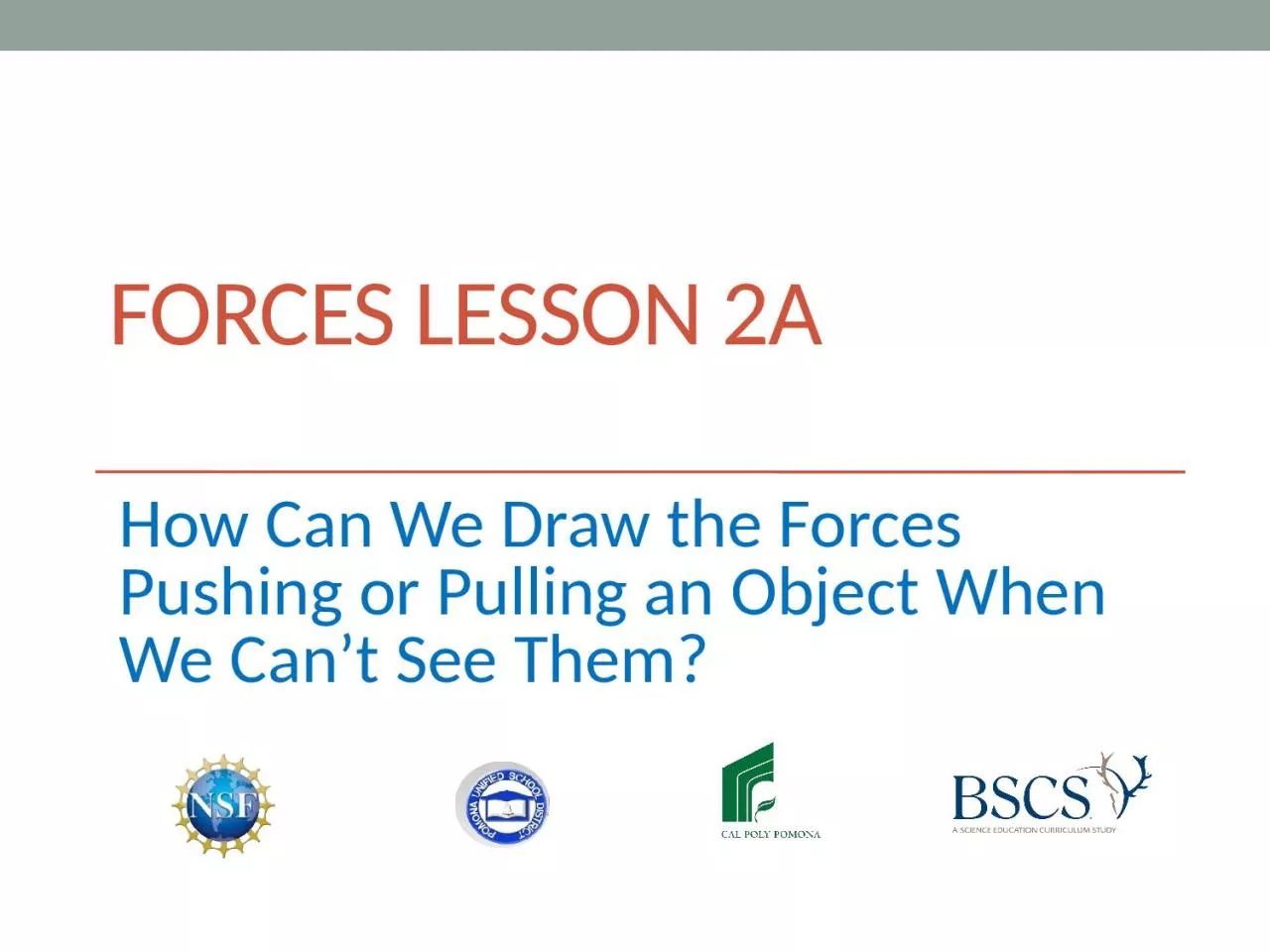

Our Focus Question from Last Time What makes something start to move How did you answer this question What did we call the actions that cause something to move Key Science Ideas ID: 1014223
Download Presentation The PPT/PDF document "Forces Lesson 2A How Can We Draw the For..." is the property of its rightful owner. Permission is granted to download and print the materials on this web site for personal, non-commercial use only, and to display it on your personal computer provided you do not modify the materials and that you retain all copyright notices contained in the materials. By downloading content from our website, you accept the terms of this agreement.
1. Forces Lesson 2AHow Can We Draw the Forces Pushing or Pulling an Object When We Can’t See Them?
2. Our Focus Question from Last TimeWhat makes something start to move?How did you answer this question?What did we call the actions that cause something to move?
3. Key Science IdeasIn science, a force is a push or pull between two objects that causes something to move.In most cases, two objects must touch to exert a force that causes motion.What force doesn’t require two objects to touch?
4. Key Science IdeasIn science, a force is a push or pull between two objects that causes something to move.In most cases, two objects must touch to exert a force that causes motion.Gravity is a special type of force that pulls an object toward Earth without requiring it to touch the ground.
5. Today’s Focus Question How can we draw the forces pushing or pulling an object when we can’t see them?
6. Talk about Your DrawingsDiscuss these questions for each drawing with a partner:Can you see a force in the drawing? What part of the drawing lets you know that something has started to move?How did you represent a force in your drawing? Can you tell if a push, a pull, or gravity caused something to move in the drawing? Can you tell how strong the force is that caused something to move?
7. Describe the ForcesCan you see a force in the drawing?What part of the drawing tells you that a force is acting on an object?How is the force represented in the drawing (with lines, arrows, or something else)? What object is exerting a force on another object?Is the force pushing or pulling the object? How can you tell?Does the drawing show the direction and strength (size) of the force?
8. Investigation: Drawing ForcesWhen a pushing force was exerted on the cart, in what direction did it move?How could we show in a diagram the direction of the force (the push) on the cart?How could we show in a diagram how strong the force was (a small, weak push or a big, strong push)?
9. Investigation: Drawing ForcesRemember: The foam arrows show both the strength and the direction of a force.What did you notice about the arrow our volunteer chose to represent the strength of the force pushing the cart?What does the length of the arrow mean?How did our volunteer show the direction of the force that made the cart move?
10. Investigation: Drawing ForcesKey science ideas: Arrows show both the strength and the direction of a force.The direction of the arrow shows the direction of the force.The length of the arrow shows how strong the force is. A shorter arrow represents a smaller, weaker force, and a longer arrow represents a larger, stronger force.
11. Today’s Focus Question How can we draw the forces pushing or pulling an object when we can’t see them?Challenge question: How can we use diagrams torepresent the forces acting on this cart? Photo courtesy of Cal Poly Pomona
12. Using Diagrams to Represent ForcesChallenge question: How can we use diagrams to represent the forces acting on this cart?Turn and Talk: Describe the forcethat the arrow represents in eachdiagram.What is the direction of the force?How strong is the force? How do you know? Photo courtesy of Cal Poly Pomona
13. Let’s Summarize!Key science ideas:A force is a push or pull between two objects that causes something to move.In most cases, two objects must touch to exert a force that causes motion.The exception is gravity, which is a special type of force that pulls an object toward Earth without requiring the object to touch the ground.
14. Let’s Summarize!Key science ideas:Scientists use arrows show the strength and direction of a force.The direction of the arrow represents the direction of the force.The length of the arrow represents the strength of the force. A shorter arrow represents a smaller, weaker force, and a longer arrow represents a larger, stronger force.
15. Next TimeWhat happens if more than one force acts on an object at the same time?In what direction would the object move, or would it move at all?How would we use arrows to represent more than one force acting on an object?We’ll explore these questions next time.